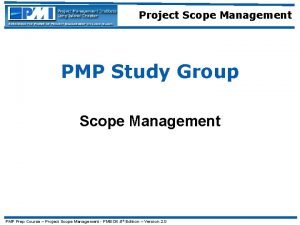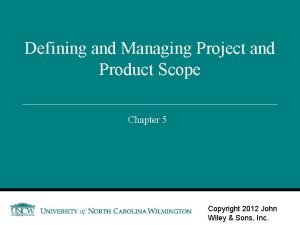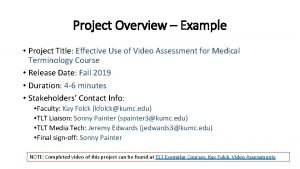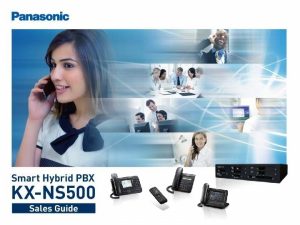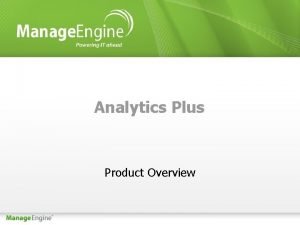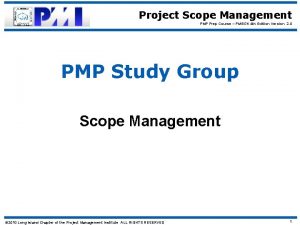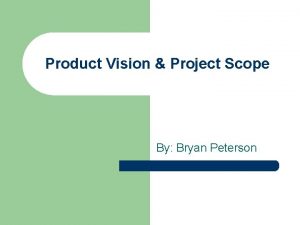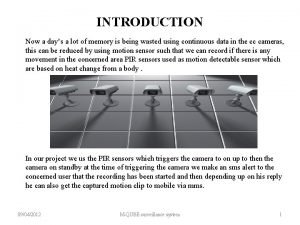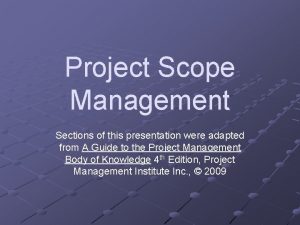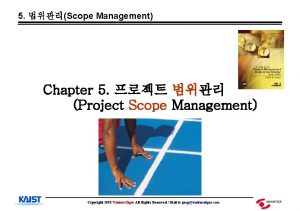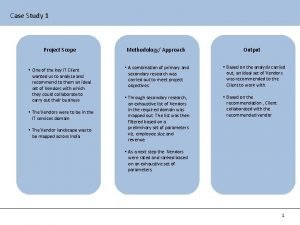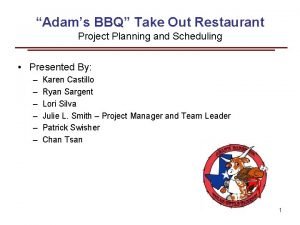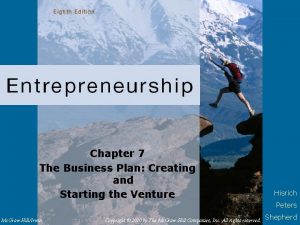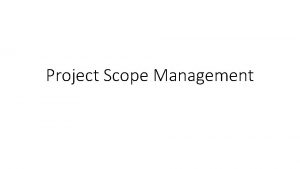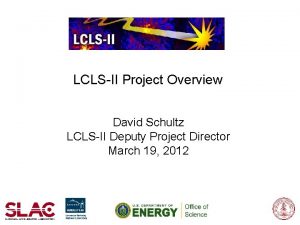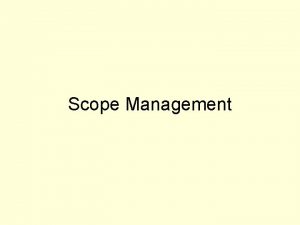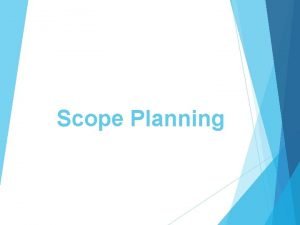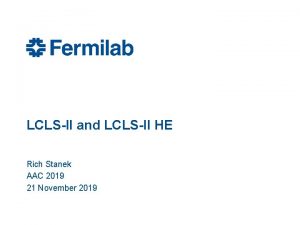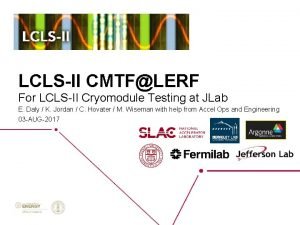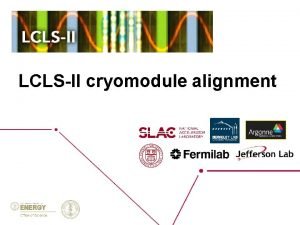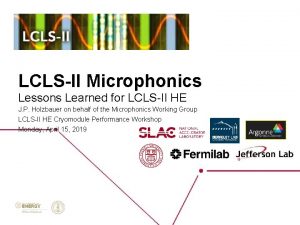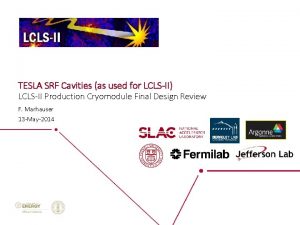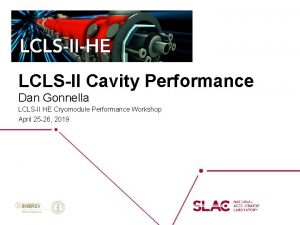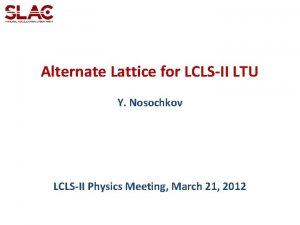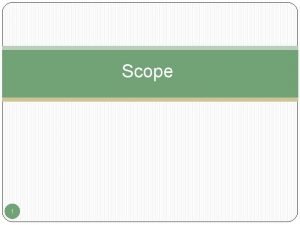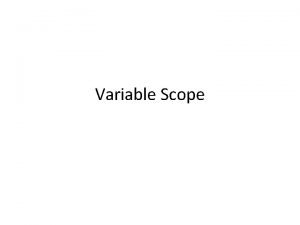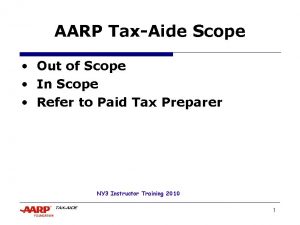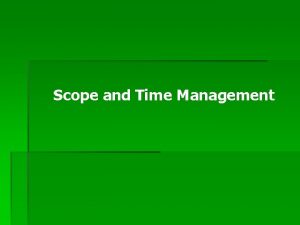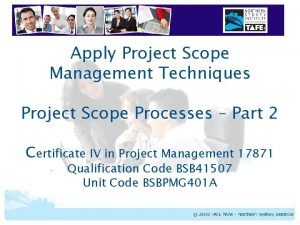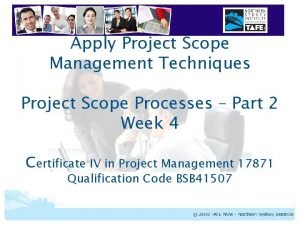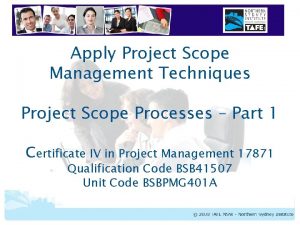LCLSII Introduction LCLSII Project Plan and Scope Overview






















- Slides: 22

LCLS-II Introduction

LCLS-II Project Plan and Scope Overview 13 September 2013

Outline • • • LCLS-II Background BESAC Recommendations LCLS-II Project Definition Operating Parameters and Source Considerations Project Timetable Partner Laboratory Integration LCLS-II Overview 3

LCLS II Scope of Work Ø Ø Ø Injector at sector 10 (120 Hz) Two variable gap undulators Soft x-ray instrument 302 m undulator tunnel 94 mx 15 m experiment hall Schedule CD-0 4/2010 CD-1 10/2011 CD-3 a 3/2012 CD-2 2012* CD-3 b 2014 CD-4 2019 *Ready for CD-2 8/2012 – Trapped by “no new starts” provision in FY 13 Continuing resolution LCLS-II Overview Slide 4

LCLS-II Key Performance Parameters Performance Measure Electron Beam Energy Photon Beam Tuning Range Additional Space for Instruments Facilities Gross Square Feet Objective KPP 13. 5 Ge. V 250 -13, 000 e. V Space for 6 Experiment Stations ~90, 000 GSF • 250 e. V - 2, 000 e. V source: • Spectroscopy at moderate peak power • High-field physics at high peak power • Nonlinear optical phenomena @ soft XR wavelengths • 2, 000 -13, 000 e. V source: • Single-shot imaging at ~1 nm to ~0. 1 nm resolution LCLS-II Overview 5

FEL Science – The BESAC recommendations: High repetition rate; at least 0. 2 -5 ke. V; high pulse energy 5 -20 ke. V High repetition rate lower peak power science: at least 0. 2 -5 ke. V High TC Superconductors Catalysis (CO on Ru) Correlated Electron Systems de novo phasing using Single Wavelength Anomalous Diffraction from Sulfur: 4 -5 ke. V Time resolved RIXS C K edge 0. 284 ke. V 0. 2 ke. V Ru LIII edge 2. 838 ke. V Cu LIII edge 0. 932 ke. V Gd MV edge 1. 190 ke. V Coherent X-ray Imaging of LCLS-II Overview magnetic domain in Gd/Fe S K edge 2. 472 ke. V Sulfur spectro-microscopy in bio/environmental science 5. 0 ke. V Non-periodic imaging: 2 -5 ke. V 6

FEL Science – The BESAC recommendations: High repetition rate; at least 0. 2 -5 ke. V; high pulse energy 5 -20 ke. V High energy per pulse science 5. 0 -20. 0 ke. V Magnetic polarities of a cobalt alloy Iridates: model strongly correlated materials Phonons in superconductivity High magnetic fields 14 -20 Ke. V disentangle competing orders Energy Loss (e. V) Fe K edge 7. 112 ke. V Co K edge 7. 712 ke. V 5 ke. V Solute-solvent interactions in photo-excited reactions Time resolved Resonant solution scattering LCLS-II Overview Ir LIII edge 11. 215 ke. V Cu K edge 8. 979 ke. V Charge-stripe ordering in LSCO superconductor Si(777) backscatter 13. 84 ke. V Se K edge 12. 658 ke. V Serial Femtosecond Crystallography de novo phasing using Multiple Wavelength Anomalous Diffraction from Selenium 20 ke. V 7

The LCLS-II Project Definition (8/16/2013) Accelerator Superconducting linac: 4 Ge. V Undulators in LCLS-I Tunnel New variable gap (north) New variable gap (south) Instruments Use existing instruments (instrument and detector upgrades needed to fully exploit) Cost (TPC) TBD with SC/BES NEH 4 Ge. V SC Linac FEH 0. 2 -1. 2 ke. V (100 k. Hz) 1. 0 - 18 ke. V (120 Hz) 1. 0 - 5 ke. V (100 k. Hz) LCLS-II Overview 8

High repetition rate beam available to all instruments with two variable gap undulators Ø Instrument upgrades and R&D needed to fully exploit high rep rate Catalysis de novo phasing using Single Wavelength Anomalous Diffraction from Sulfur: 4 -5 ke. V High TC Superconductors Pump-Probe Time resolved RIXS Serial Femtosecond Crystallography 0. 2 -1. 2 ke. V (100 k. Hz) 4 Ge. V @100 k. Hz 14 Ge. V @120 Hz 1. 0 - 18 ke. V (120 Hz) 1. 0 - 5 ke. V (100 k. Hz) Time resolved Resonant solution scattering LCLS-II Overview Time resolved RIXS Iridates: model strongly correlated materials 9

Operating modes • North and south undulators always operate simultaneously in any mode Undulator SC Linac (up to 100 k. Hz) North 0. 25 -1. 2 ke. V South 1. 0 -5. 0 ke. V Cu Linac (up to 120 Hz) up to 18 ke. V higher peak power pulses • Concurrent operation of 1 -5 ke. V and 5 -18 ke. V is not possible 0. 2 -1. 2 ke. V (100 k. Hz) 4 Ge. V SC Linac Cu Linac LCLS-II Overview 1. 0 - 18 ke. V (120 Hz) 1. 0 - 5 ke. V (100 k. Hz) 10

Preliminary Operating Parameters Preliminary LCLS-II Summary Parameters North Side Source v 0. 7 8/30/13 South Side Source Running mode SC Linac Cu Linac Repetition rate up to 1 MHz* 120 Hz 4 Ge. V 14 Ge. V 0. 25 -1. 2 ke. V 1 -5 ke. V 1 -20 ke. V up to 2 m. J* up to 10 m. J 3. 9 x 1030 ** 12 x 1030 ** 247 x 1030 ** 3. 0 x 1030 ** 6. 9 x 1030 ** 121 x 1030 ** Electron Energy Photon energy Max Photon pulse energy (m. J) (full charge, long pulse) Peak Spectral Brightness (10 fs pulse) (low charge, 10 p. C) Peak Spectral Brightness (100 fs pulse) (full charge, 100 p. C) * Limited by beam power on optics **N_photons/(s*mm^2*mrad^2*0. 1% bandwidth) LCLS-II Overview 11

We Need the Help of Partner Labs for • Superconducting linac and cryosystems • High brightness, high repetition rate gun/injector • New soft x-ray undulator and • A hard x-ray undulator that replaces the existing LCLS undulator LCLS-II Overview 12

The Next Steps for SLAC to Engage Partners • Visit the prospective partner labs: • • LBNL 5 Sept. FNAL 10 Sept. ANL 11 Sept. JLAB 13 Sept • Share parameter list • Ask for preliminary information on scope, schedule, cost • Ask readiness assessment for each element from the lab • Ask for development: scope, schedule, cost • Share information during workshop • Refine project plan LCLS-II Overview 13

Potential Areas of Collaboration with Partner Labs SLAC LBNL Injector X Undulator X FNAL JLAB X X SC Linac X X SC cryo line X X Cryo plant X X X RF systems X Beam Physics X Instruments/ Detectors X PM/Integration X Installation X Commissioning X LCLS-II Overview Cornell Wisconsin X X X SC linac prototype LLRF ANL X X X 14

Timeline for the next 6 month Ø Next 6 weeks: Partner lab visits • Oct 15 -17: Workshop at SLAC with all partner labs to freeze preliminary design, scope, prototype development plan Ø Development basis of estimate documents, integrated schedule, integrated cost estimates. Ø Negotiate with partner labs and review on scope, schedule and cost. Ø In parallel: Start prototype developments and procurements • November 25: integrated scope-schedule-cost assembled Ø Revise documents • Directors review Dec 13 -14 -15 • Adjust arrangements based on review outcome, if necessary Ø Revise documents • Lehman review Jan 14 -15 -16, 2014 • Adjust arrangements based on review outcome, if necessary 15

SLAC Points of Contact • For ongoing exchange of information • Leading to definition of the collaboration • • • Labs’ scopes of work Personnel and RRAA Exchange of technical/cost/schedule information FEL/Accelerator Physics Tor Raubenheimer Tor@slac. stanford. edu 1 650 926 2474 Injector John Schmerge schmerge@slac. stanford. edu 1 650 926 2320 Undulators & photon systems Michael Rowen rowen@slac. stanford. edu 1 650 926 3487 Linac Marc Ross mcrec@slac. stanford. edu 1 650 926 3574 Cryoplant Robert Law rlaw@slac. stanford. edu 1 650 926 4586 Business Systems Cindy Lowe cindy@slac. stanford. edu 1 650 926 2279 Cost/Schedule/EVMS Richard M. Boyce boyce@slac. stanford. edu 1 650 926 3441 QA & System Integration Lori J. Plummer lorijp@slac. stanford. edu 1 650 926 4834 Management Galayda Schultz galayda@slac. stanford. edu dcs@slac. stanford. edu 1 650 926 2371 1 650 926 2459 DOE September 3, 2013 Tele. Video 16

Integration Between SLAC and Partner Labs • Basic Roles and Responsibilities: SLAC • • Partner Laboratory • • • Interface with DOE: BES & SC Accountable for performance of the entire project including oversight of partner labs’ performance Baseline, EVMS & contingency control Overall project management • • • System design and integration Setting performance specifications Performance verification Building construction Integration / QA / Safety / Schedule Construction overhead rate agreement • • • Designing/detailing to specification Procuring / Manufacturing Delivering Conformance Interlab QA Construction overhead rate agreement • • Installation Testing + Commissioning & Operation • • Supporting installation Supporting commissioning LCLS-II Overview • • Responsible for management of work on agreed-upon scope Meeting project requirements for subsystems Effective, efficient management of project activities to meet overall goals 17

Project Collaboration • The Project (SLAC, partner labs and all) must function as a SINGLE organization with a SINGLE set of priorities • The Project must face and resolve challenges to the success of the project in all areas (cost/schedule/technical) • This requires commitment to the Project’s goals at SLAC and at partner labs • This requires the collaborating labs have confidence that the burden of solving problems is shared fairly • This requires that each of the collaborating labs accept responsibility for achieving best all-around performance through good management, planning and execution DOE September 3, 2013 Tele. Video 18

Project Collaboration Technical teams discuss and agree to (if possible): • PM/PLM software packages • Procurement database • Staffing profiles, org charts, time sheet verification etc Lab Senior Management discuss and agree to: • High Level time line • Establishment of Lab Directors council • Roles and responsibilities between partner labs • Construction overhead rates • Senior team leaders in each lab 19

Summary • Envisioned facility fulfills all BESAC Light source subcommittee recommendations • New Scientific Capabilities • Leverages Existing SLAC infrastructure • Partner laboratories DOE September 3, 2013 Tele. Video 20

Discussion LCLS-II Overview 21

Back-Up LCLS-II Overview 22
 Scope management pmp
Scope management pmp Product scope vs project scope
Product scope vs project scope Multicullar
Multicullar Example of project title
Example of project title Sap project systems overview
Sap project systems overview Project management topics
Project management topics Papercut job ticketing
Papercut job ticketing Introduction product overview
Introduction product overview Introduction product overview
Introduction product overview Introduction product overview
Introduction product overview Project charter and scope statement
Project charter and scope statement Product vision and project scope
Product vision and project scope Conclusion and future scope of project
Conclusion and future scope of project Example of project scope statement
Example of project scope statement Activity diagram for gym management system
Activity diagram for gym management system Project scope presentation
Project scope presentation Wbs dictionary example
Wbs dictionary example Project scope management case study
Project scope management case study Restaurant project plan
Restaurant project plan Projscope
Projscope Project scope presentation
Project scope presentation It project scope management
It project scope management Scope of business plan
Scope of business plan
